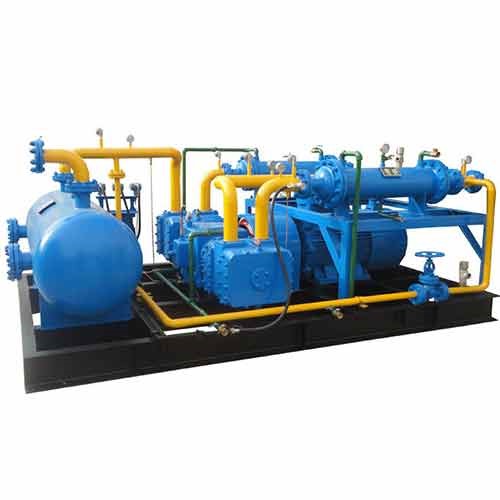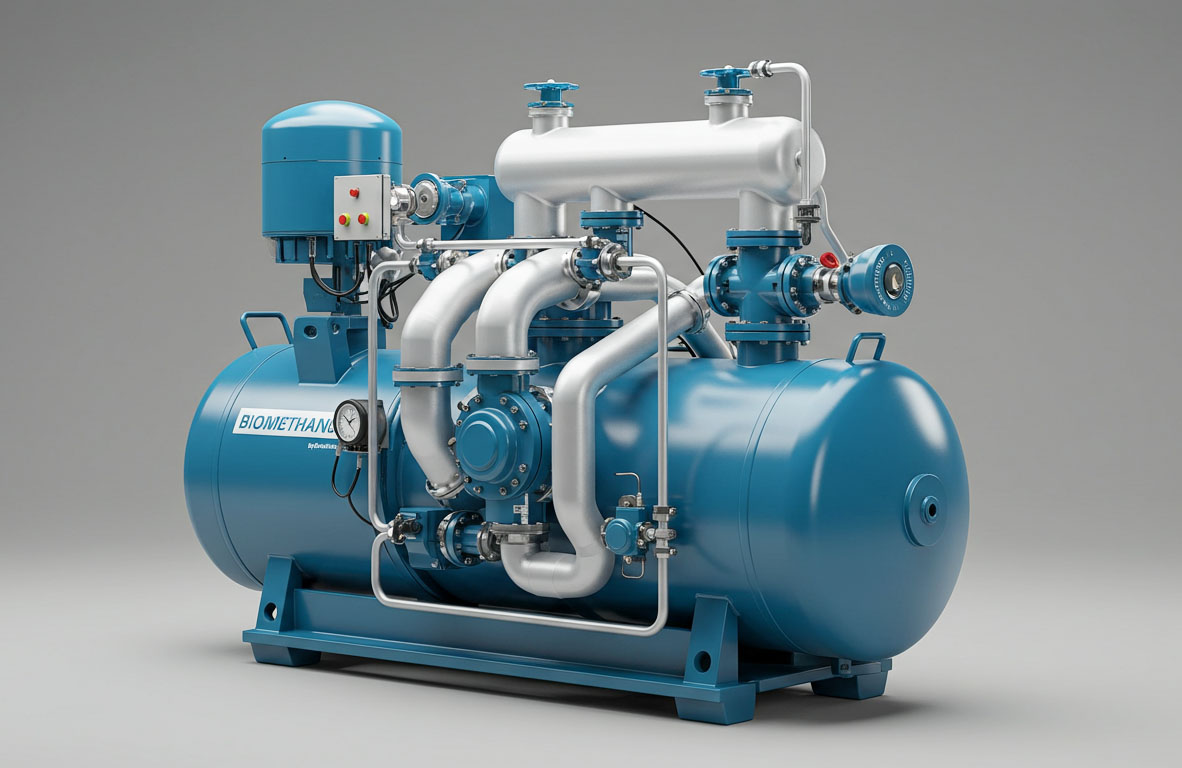Reliable Sulfur Dioxide Gas Compressor for SO2 Reciprocate Applications
Find a reliable sulfur dioxide gas compressor for industrial reciprocate applications. Upgrade your capabilities with a trusted supplier of SO2 compressors.

Introduction
Sulfur dioxide (SO2) plays a crucial role in various industrial applications, from food preservation to chemical manufacturing. To harness the potential of SO2 efficiently, industries rely on specialized equipment like sulfur dioxide gas compressors. In this comprehensive guide, we’ll delve into the intricacies of sulfur dioxide gas compressors, exploring their functions, working mechanisms, key components, advantages, and considerations for industrial applications.
What is a Sulfur Dioxide Gas Compressor?
A sulfur dioxide gas compressor is a vital piece of equipment designed to handle and compress SO2 gas for various industrial processes. This compressor is specifically engineered to withstand the challenges associated with handling sulfur dioxide, ensuring reliable and efficient performance in diverse applications.
Understanding the Function of a Sulfur Dioxide Gas Compressor
The primary function of a sulfur dioxide gas compressor is to elevate the pressure of SO2 gas, making it suitable for different industrial processes. This compression is essential for transporting and utilizing SO2 effectively, as many applications require the gas to be in a compressed state to enhance efficiency.
How Does a Sulfur Dioxide Gas Compressor Work?
Sulfur dioxide gas compressors operate based on the principles of reciprocating motion. In a reciprocating compressor, a piston moves back and forth within a cylinder, creating a suction and compression cycle. This cyclic motion allows the compressor to draw in sulfur dioxide gas, compress it, and then discharge it at the required pressure.
Importance of Sulfur Dioxide Gas Compressors in Industrial Applications
Sulfur dioxide is a versatile compound used in various industrial processes, including refrigeration, chemical synthesis, and wastewater treatment. The use of a reliable sulfur dioxide gas compressor is crucial to ensure a stable and controlled supply of compressed SO2, meeting the specific requirements of each application.
Key Components of a Sulfur Dioxide Gas Compressor
Understanding the key components of a sulfur dioxide gas compressor is essential for assessing its reliability and performance. Common components include a cylinder, piston, valves, motor, and a lubrication system. Each part plays a critical role in the compressor’s overall functionality and efficiency.
Advantages of Using Sulfur Dioxide Gas Compressors
Sulfur dioxide gas compressors offer several advantages in industrial settings. These include:
- Efficient Compression: Sulfur dioxide gas compressors efficiently elevate the pressure of the gas, ensuring optimal performance in various applications.
- Reliability: Designed for the challenges of handling SO2, these compressors are reliable and durable, contributing to long-term operational stability.
- Versatility: Sulfur dioxide gas compressors are versatile, adapting to different industrial processes that require compressed SO2.
- Cost-Effectiveness: The efficient compression and reliability of these compressors contribute to cost-effective industrial operations.
Where Can You Find Reliable Sulfur Dioxide Gas Compressors?
Choosing a reliable supplier is crucial when acquiring sulfur dioxide gas compressors. Reputable manufacturers and distributors specializing in industrial compressors are the go-to sources. Additionally, online platforms and industry-specific trade shows can provide insights into available options.
Choosing the Right Supplier for Sulfur Dioxide Gas Compressors
Selecting the right supplier is a critical decision that can impact the performance and longevity of sulfur dioxide gas compressors. Consider the following factors when evaluating potential suppliers:
- Experience and Reputation: Opt for suppliers with a proven track record and positive industry reputation.
- Compliance with Standards: Ensure that the compressors meet industry standards and safety regulations.
- Customization Options: Choose a supplier that offers customization to meet specific industrial requirements.
- After-Sales Support: Assess the availability of maintenance services, spare parts, and technical support.
Factors to Consider When Selecting a Sulfur Dioxide Gas Compressor Supplier
Several factors should influence your decision when selecting a sulfur dioxide gas compressor supplier:
- Quality and Durability: Prioritize suppliers known for producing high-quality and durable compressors.
- Customer Reviews: Seek feedback from other industrial users to gauge customer satisfaction with a particular supplier.
- Technical Specifications: Ensure that the compressors offered meet the technical specifications required for your industrial processes.
- Price Competitiveness: While cost is a consideration, prioritize value for money over the lowest price.
Key Features to Look For in a Sulfur Dioxide Gas Compressor
When evaluating sulfur dioxide gas compressors, pay attention to the following key features:
- Material Quality: The materials used in the construction of the compressor should be corrosion-resistant and suitable for handling SO2.
- Safety Features: Look for compressors with safety features such as pressure relief valves and emergency shutdown systems.
- Efficiency Ratings: Consider the energy efficiency ratings of the compressors to minimize operational costs.
- Control Systems: Opt for compressors with advanced control systems for precise pressure and flow regulation.
Comparing Sulfur Dioxide Gas Compressors from Different Manufacturers
Comparing compressors from different manufacturers involves a thorough assessment of technical specifications, performance data, and customer reviews. Look for manufacturers with a history of producing reliable compressors and assess how well their products align with your specific industrial needs.
Blackmer Sulfur Dioxide Gas Compressors for Industrial Use
Blackmer, a renowned name in industrial compressors, offers a range of sulfur dioxide gas compressors designed for optimal performance in various applications. Known for their reliability and efficiency, Blackmer compressors are a trusted choice for industries relying on compressed SO2.
What Are the Key Considerations for Using Sulfur Dioxide Gas Compressors in Industrial Applications?
Implementing sulfur dioxide gas compressors in industrial settings requires careful consideration of several factors:
- Environmental Impact: Evaluate the environmental impact of using compressed SO2 and implement measures to minimize any potential harm.
- Regulatory Compliance: Ensure that your industrial processes comply with local and international regulations governing the use of sulfur dioxide.
- Process Integration: Integrate sulfur dioxide gas compressors seamlessly into your industrial processes for optimal efficiency.
- System Monitoring: Implement a robust monitoring system to detect any abnormalities or malfunctions in the compressor operation.
Ensuring Safety When Using Sulfur Dioxide Gas Compressors
Safety is paramount when working with sulfur dioxide gas compressors. Implement the following safety measures:
- Training Programs: Conduct regular training programs for personnel handling sulfur dioxide gas compressors.
- Safety Protocols: Establish clear safety protocols for compressor operation, maintenance, and emergency situations.
- Protective Gear: Provide personnel with appropriate protective gear, including respiratory equipment and safety clothing.
- Emergency Response Plans: Develop detailed emergency response plans to address any incidents involving sulfur dioxide gas compressors.
Lubrication Requirements for Sulfur Dioxide Gas Compressors
Proper lubrication is essential for the efficient and smooth operation of sulfur dioxide gas compressors. Use lubricants compatible with SO2 and adhere to recommended maintenance schedules to prevent wear and tear on critical components.
Compatibility of Sulfur Dioxide Gas Compressors with Other Industrial Equipment
When integrating sulfur dioxide gas compressors into an industrial system, ensure compatibility with other equipment. Evaluate the interconnected components to prevent issues such as pressure mismatches or material incompatibility that could compromise the overall system performance.
Addressing Corrosion Issues in Sulfur Dioxide Gas Compressors
Sulfur dioxide can be corrosive, and addressing corrosion issues is crucial for maintaining the longevity of compressors. Employ corrosion-resistant materials in the construction of compressors and implement corrosion monitoring systems to detect and address any signs of degradation promptly.
Maintenance and Spare Parts for Sulfur Dioxide Gas Compressors
Regular maintenance is key to ensuring the longevity and reliability of sulfur dioxide gas compressors. Develop a comprehensive maintenance schedule that includes routine inspections, lubrication, and replacement of wear-prone components. Maintain an inventory of essential spare parts to minimize downtime in case of unexpected failures.
How to Optimize the Performance of Sulfur Dioxide Gas Compressors?
Optimizing the performance of sulfur dioxide gas compressors involves a combination of best practices and operational strategies:
- Regular Inspections: Conduct routine inspections to identify and address potential issues before they escalate.
- Optimal Pressure and Flow: Monitor and adjust pressure and flow settings to match the requirements of specific industrial processes.
- Efficient Cooling: Implement efficient cooling systems to prevent overheating and ensure consistent compressor performance.
- Advanced Control Systems: Utilize advanced control systems for real-time monitoring and adjustment of compressor operations.
Implementing Best Practices for Operating Sulfur Dioxide Gas Compressors
Adhering to best practices is essential for safe and efficient operation:
- Proper Training: Ensure that personnel operating sulfur dioxide gas compressors are adequately trained on safety procedures and equipment operation.
- Documentation: Maintain detailed documentation of all operational and maintenance activities to track performance and identify areas for improvement.
- Regular Audits: Conduct regular audits of compressor operations to identify opportunities for optimization and compliance with industry standards.
Enhancing Efficiency and Minimizing Energy Consumption in Sulfur Dioxide Gas Compressors
Efficiency is a critical factor in industrial operations. To enhance efficiency and minimize energy consumption:
- Energy-Efficient Motors: Invest in compressors equipped with energy-efficient motors to reduce overall power consumption.
- Variable Speed Drives: Utilize variable speed drives to match compressor speed with the actual demand, avoiding unnecessary energy consumption during low-demand periods.
- Periodic Performance Assessments: Periodically assess the performance of sulfur dioxide gas compressors to identify and rectify any inefficiencies.
Addressing Common Issues and Troubleshooting Sulfur Dioxide Gas Compressors
Despite their reliability, sulfur dioxide gas compressors may encounter issues. Develop a troubleshooting protocol that includes:
- Diagnostic Tools: Implement diagnostic tools to quickly identify and isolate issues affecting compressor performance.
- Expert Support: Establish a relationship with the manufacturer or a qualified service provider for expert assistance in troubleshooting complex problems.
- Root Cause Analysis: Conduct root cause analyses to identify the underlying issues behind recurring problems and implement corrective measures.
Customization Options for Sulfur Dioxide Gas Compressors
Industrial processes vary, and customization may be necessary to meet specific requirements. Look for suppliers that offer customization options, allowing you to tailor sulfur dioxide gas compressors to the unique needs of your application.
Upgrading Sulfur Dioxide Gas Compressors for Specific Industrial Applications

As industrial processes evolve, upgrading sulfur dioxide gas compressors may be necessary. Consult with the manufacturer to explore upgrade options that align with the latest technological advancements and industry standards.
What Are the Maintenance and Safety Protocols for Sulfur Dioxide Gas Compressors?
Implementing comprehensive maintenance and safety protocols is crucial for the reliable and safe operation of sulfur dioxide gas compressors:
- Regular Inspections: Schedule routine inspections to identify wear and tear, leaks, or other potential issues.
- Lubrication Management: Adhere to recommended lubrication schedules and use high-quality lubricants compatible with sulfur dioxide.
- Emergency Drills: Conduct regular emergency drills to ensure that personnel are well-prepared to respond effectively to compressor-related incidents.
- Compliance Checks: Periodically review and update safety protocols to ensure compliance with evolving industry standards and regulations.
Essential Maintenance Tasks for Ensuring the Longevity of Sulfur Dioxide Gas Compressors
Extend the lifespan of sulfur dioxide gas compressors by prioritizing essential maintenance tasks:
- Filter Replacement: Regularly replace filters to prevent contaminants from compromising compressor performance.
- Valve Inspections: Inspect valves for leaks and wear, addressing issues promptly to maintain optimal compression efficiency.
- Cylinder and Piston Maintenance: Monitor the condition of cylinders and pistons, and perform necessary maintenance to prevent deterioration.
- System Audits: Conduct periodic system audits to identify areas for improvement in overall compressor performance.
Handling and Storing Sulfur Dioxide Gas in Conjunction with Compressors
Safe handling and storage of sulfur dioxide gas are critical components of industrial operations involving compressors:
- Secure Storage Facilities: Store sulfur dioxide gas in designated and secure facilities, adhering to safety guidelines and regulations.
- Proper Ventilation: Ensure proper ventilation in storage areas to prevent the accumulation of potentially harmful concentrations of SO2.
- Handling Protocols: Train personnel on safe handling practices, including the use of protective equipment and emergency response procedures.
Ensuring Compliance with Regulatory Standards for Using Sulfur Dioxide Gas Compressors
Adherence to regulatory standards is non-negotiable when using sulfur dioxide gas compressors in industrial applications:
- Regular Audits: Conduct regular audits to verify compliance with local, national, and international regulatory standards.
- Documentation: Maintain detailed documentation of compliance measures, including certifications, inspections, and adherence to safety protocols.
- Continuous Education: Stay informed about evolving regulatory requirements to proactively adapt operational practices and maintain compliance.
Training and Safety Measures for Personnel Working with Sulfur Dioxide Gas Compressors
Investing in personnel training and safety measures is crucial for a secure working environment:
- Comprehensive Training Programs: Develop and implement comprehensive training programs covering the safe operation, maintenance, and emergency response associated with sulfur dioxide gas compressors.
- Regular Refresher Courses: Conduct regular refresher courses to reinforce safety protocols and ensure that personnel remain well-informed.
- Safety Culture: Foster a safety-conscious culture within the organization, encouraging open communication and reporting of safety concerns.
Emergency Protocols and Response for Sulfur Dioxide Gas Compressor Incidents
Prepare for emergencies with well-defined protocols and response strategies:
- Emergency Shutdown Systems: Install and regularly test emergency shutdown systems to swiftly halt compressor operations in case of an incident.
- Evacuation Plans: Establish clear evacuation plans, ensuring that personnel know the designated evacuation routes and assembly points.
- Communication Protocols: Implement robust communication protocols to facilitate quick and effective coordination during emergency situations.
Conclusion
In conclusion, the utilization of sulfur dioxide gas compressors is integral to various industrial processes. Understanding their functions, key components, advantages, and proper maintenance is essential for ensuring reliable performance and longevity. By choosing a reputable supplier, adhering to safety protocols, and staying compliant with regulatory standards, industries can harness the benefits of sulfur dioxide gas compressors while mitigating potential risks. The continuous evolution and optimization of operational practices will contribute to a safer and more efficient industrial landscape.


